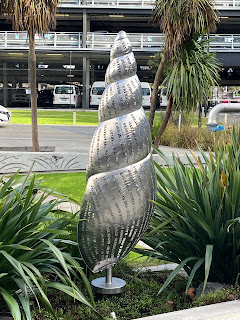In response to a local authority comment on social media about the impending installation of a piece of public art recently, there was the inevitable 'what are you wasting rate payer money for?' response. It included the also inevitable 'go fix some potholes' reference too. I'm a fan of public art, and for no other reason that I have liked them, I have been accumulating photos on my 'phone when I have seen cool examples around Ōtautahi. I've also noted and captured a few examples from Ōtepōti, and Oamaru. Here are a few examples. In the selection is also an example from a 'private' restaurant space too .. art, it seems, can be found all over the place. I've left these photos to the end of this post so as to not intrude too far in my comments. So what?
Having led a kura for seven years, one in which we embedded the vision 'he puna auaha a centre of creative excellence', and one of a network of over 130 kura across Aotearoa New Zealand (the Manaiakalani network) for which the underlying pedagogy is 'learn create share', you'd hope that I had a little more reason for such things than simply 'it seemed like a good idea at the time'. And I have.
There is the work of Professor Peter O'Connor here in Aotearoa (University of Auckland) on creativity in schools to lead the way in my thinking. In what for me as a reader and educational practitioner was a ground breaking paper 'Replanting creativity in post normal times' Peter and his colleagues spelt out the case for creativity in education, covering off wellbeing and learning benefits for all.
And now I am in the process of reading the book 'Your Brain on Art' by Magsamen and Ross (2023).
Now to some degree the book feels a little like some of the 'pop psychology' that has run through our educational discourse for the past few decades, but I am reliably assured that there is some very good stuff in there. It's one of those books that I 'want to believe', hence my question to an academic colleague about its reliability. The book gives repeated evidence of the impact of the creative arts on our wellbeing, on who we are, on pain relief, on dealing with trauma, coping with the inevitable 'end of life, on learning. The evidence is substantial. I've been aware of the therapeutic impact of creativity on our wellbeing for some time, and here it is spelt out with what, with my non academic background, seems to be solid research and practitioner evidence.
Consider this:
HEART ('Healing and Education through the Arts') has collected data over the years to assess how the arts support our wellbeing, particularly those who are most vulnerable. Their research has shown that self expression, communication, concentration, and emotional regulation vastly improve in the program. When HEART is in a school, attendance goes up, and learning metrics improve. Most important, interest in learning improves, which is perhaps the greatest gift you can give a person: the curiosity and excitement to learn. Children develop a future forward mindset. In some of the most marginalised communities, children dare to dream about what their lives might become. And because they are emotionally agile, they are open and eager." (page 87)
Now consider this: what if schools across entire communities emphasised the arts more? (The authors are at great pains, by the way, to talk about arts AND science, not arts OR science). What if entire communities were nudged, nurtured, encouraged, resourced, to support involvement in the creative arts? What if from the youngest age groups cities saw the creative arts as a part of their preventative health investment and infrastructure, not just the money spent on treatment and palliative care, on ambulances at the bottom of those so many cliffs?
For the Manaiakalani schools network creativity is central to their work (bearing in mind that when they use the word 'create' in their pedagogy is has a much broader meaning).
I saw the impact of that focus on engagement, and outcomes, over the years across the network.
I am now a trustee on the Ako Ōtautahi-Learning City Christchurch trust. Their vision is:
"Ako Ōtautahi Learning City Christchurch champions learning as a way to transform lives, communities and organisations."
What if they were successful in connecting across our city's vulnerable groups, in building the trust and confidence of those vulnerable groups, in building connection with our creative communities and opportunities, such that our most vulnerable are enabled to be their best selves, giving to their communities just some of their enormous untapped potential, to live their best lives? What if that reach covered the many cultures that co-exist within our communities, and what if that reach enabled us all to participate in a truly bi-cultural community where we are all our best selves, comfortable in who we are, in where we came from? What if we celebrated creativity for what it is: one of the things that makes us profoundly human?
I am brought back yet again to this wonderful whakataukī:
Nāu te rourou, nāku te rourou, ka ora ai te iwi
With your food basket and my food basket the people will thrive
There is a great quote in the lines of Robin Williams' character in the movie 'Dead Poets Society' in which he says:
"We read and write poetry because we are members of the human race. And the human race is filled with passion. And medicine, law, business, engineering, these are noble pursuits and necessary to sustain life. But poetry, beauty, romance, love, these are what we stay alive for."
A city that values and nurtures creativity: what sort of city would that be to live in?
Here are just some of the fabulous examples of public art I referred to at the start.















No comments:
Post a Comment